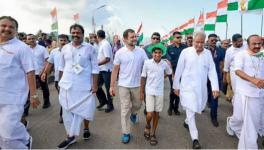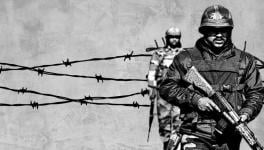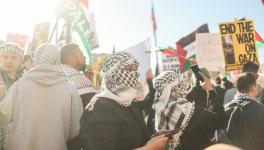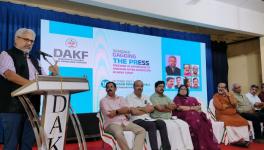From Coonoor to Nagaland: Two Funerals, Worthy and Unworthy Victims
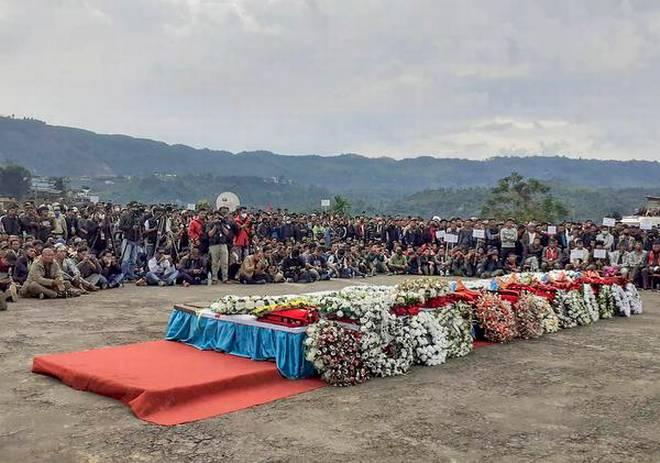
Image Courtesy: PTI
The images are haunting—bodies encased in coffins or sheaths, wreaths or flower petals laid with reverence for the departed, tears of grief, haunted eyes, and an occasional string of words that exemplifies dignity and grace in the face of brutal death. They filled our television screens, social media feeds, and newspaper pages for a larger part of the week that went by, drawing messages of commiseration and condolences from Indians. Yet, the aftermath of the unfortunate helicopter crash, which took the lives of 13 including Chief of Defence Staff (CDS) Gen Bipin Rawat, was only half the story. The other half barely even made it to our screens and feeds.
In the story that India and its media forgot, there weren’t any candles or prayers or petals showered on the dead; there weren’t slogans from people lining streets, and if there were, they didn’t fill the top section of the ‘national’ news feed. The 14 Indians, civilians returning from work in a mine in Mon district in Nagaland and villagers who protested their killing were laid to rest away from the media attention and without fellow Indians grieving over their brutal deaths. They were all felled by bullets fired by commandos of the Indian Army (an army man was killed by enraged villagers too) in what the government of India justified as “a case of mistaken identity”. [The police have filed a case citing 'intent to murder' against the 21 Para Special forces of the army for the incident.]
Every death deserves to be mourned. That of India’s CDS, the nation’s highest defence officer in uniform, calls for protocol too. It was, it would be, the top-most story in news feeds and the public consciousness. The circumstances of the helicopter crash on 8 December afternoon near Coonoor, Tamil Nadu, raised several questions. Within hours of the crash, conspiracy theories gathered momentum, especially on social media platforms, lending an air of suspense to the accident. Retired senior Army and Air Force personnel, aviation experts and others attempted to answer some.
Deepening the tragedy was the death of his wife Madhulika and 11 other army personnel, including Brigadier LS Lidder, Lt Col Harjinder Singh, Squadron Leader K Singh, Nai Gursewak Singh, Naik Jitender Kumar, Naik Vivek Kumar, Naik BS Teja, Havaldar Satpal, JWO Das, JWO Pradeep A, and the pilot Wing Commander Prithvi Singh Chauhan. The symbolism that accompanies the death of a person occupying a high-profile public office leads many to feel a sense of loss and bereavement, an indirect grief. CDS Rawat’s position ensured that the story would not be moved from the top of news feeds.
Given the hyper-nationalist climate in the country cleverly stoked by the ruling Bharatiya Janata Party in election after election—and in between, too—it was easy to turn the funeral procession of CDS Rawat and his wife into yet another disturbing display of political nationalism. Many Twitter users pointed out that in the wreath-laying ceremony, Prime Minister Narendra Modi tweeted out four photos in which he happened to be in sharp focus, and everything or everyone else, including the name on Madhulika Rawat’s casket, was blurred out.
The political and often unnecessary statements that CDS Rawat had made since his elevation to the newly created post had been put aside, given the sombreness of the occasion. Fittingly so, though, they must be revisited by historians and independent analysts later to unpack how the nation’s highest military officer aligned with not only the government of the day but the ruling party, and the repercussions it will have on India’s forces.
As the Rawats were laid to rest, people watched the solemn proceedings on their screens and candles were lit at various places, including in Srinagar. The poise and grace shown by Brig Lidder’s wife and teenage daughter—trolled for her opinions on the day she bid goodbye to her father—won hearts. The nation grieved with them as they participated in the ceremonious farewell.
Other men in uniform in faraway Nagaland had, in a blink of an error, an unpardonable error, ended the lives of 14 Indian citizens. These victims received neither homage nor attention from the mainstream media or its ‘national’ audiences. Their bodies were lined up, prepared for the final farewell by their grieving relatives, whose grief was not on our screens and social media feeds, whose wails did not reach our ears. The Mon killing story barely stirred Indians.
Were they lesser victims, unworthy victims? Were the mineworkers and their fellow villagers not as worthy of attention as the victims of the chopper crash? The worthy-unworthy victim binary, framed by linguist-intellectual Noam Chomsky, shows us the selectivity with which the media and power elite set the narrative in which different categories of victims receive differing levels of media—and therefore public—attention.
The deaths on 4 December in Nagaland were not an unfortunate accident akin to an air crash. These were killings, allegedly at point-blank range, by men in uniform, which highlight the inevitability of impunity where the Armed Forces Special Powers Act (AFSPA) is in force—as has been happening in Kashmir. The story should have rocked the nation, caused sleepless nights for the Modi government and Union Home Minister Amit Shah, and led the media to Oting-Mon for a series of follow-up stories. The armed forces are, after all, accountable.
Instead, the story quickly went off the front pages of newspapers and television screens, dropped out of social media feeds and hashtags, and subsequently retreated from the public consciousness. This would not have happened had the largest and most prominent media houses stationed their best journalists there for a week and more. The short video clips or the odd photo that floated around in the media of grieving relatives with the bodies appeared due to the diligent efforts of a few local journalists to not allow the killings to go off the news radars—and the nation’s conscience.
The Oting Citizens Office, representing the village Oting, put out a statement about that fateful evening accusing the armed forces of attempting to brand the killed men as militants by planting weapons and dressing them in camouflage and boots. It is a serious allegation, but it barely made the news.
Facts are already twisted. Shah, while expressing regret over the incident in the Lok Sabha, stated that the Army was acting on intelligence that insurgents were moving in the area, had signalled the vehicle to stop, and had fired when it tried to flee. Villagers told the local media that there was no signal to stop, all vehicles moved slowly due to bad road conditions, and the first bullet had been fired at the driver through the wind-shield (raising the question if it was possible if the vehicle was fleeing), who was killed on the spot. The BJP’s ally in the region, the National People’s Party, too questioned Shah’s version and said he had “twisted facts”.
By any parameter, all aspects of this story should have grabbed headlines for days. Instead, there was a trickle. The story had turned administrative—announcement of a Special Investigating Team probe, a court of inquiry against the officers, and so on. From the news spot itself, there was little. Of the victims and their relatives, mainly of the Konyak tribe, we heard and saw little. Thirty-six-year-old Langton Konyak leaves behind a two-month-old daughter, 37-year-old Hokup Konyak was the primary earner of his family and had married barely a fortnight earlier. Who were the others who took the Indian Army’s bullets, who do they leave behind, what is the Konyak Union about?
This is not merely about the tyranny of distance, as is often cited for not focussing on stories from the Northeastern states; this is about the media choosing to look away from the uncomfortable questions about both the government and the armed forces. Digging deeper into the killings would mean raising questions about both—a prospect that large sections of the mainstream media do not relish or even see as their job any more.
For them, it was easier, less expensive, and politically prudent to focus on the men in uniform who died in an unfortunate accident than on the victims of men in uniform who pumped bullets mistaking their identity. But, in this, we the citizens are all diminished.
The author, a senior Mumbai-based journalist and columnist, writes on politics, cities, media and gender. The views are personal.
Get the latest reports & analysis with people's perspective on Protests, movements & deep analytical videos, discussions of the current affairs in your Telegram app. Subscribe to NewsClick's Telegram channel & get Real-Time updates on stories, as they get published on our website.










